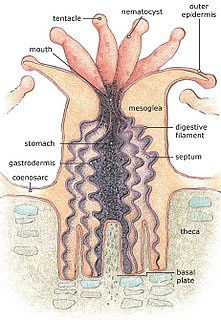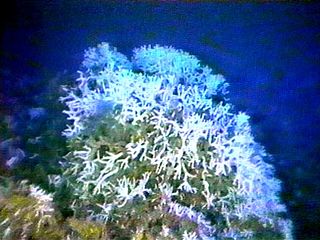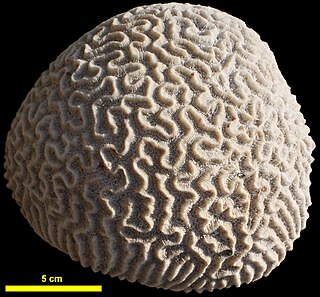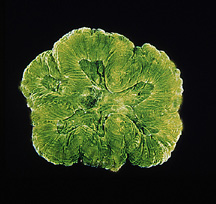In corals, the coenosteum is the stony skeletal material secreted by the coenosarc, the layer of living material lying between the corallites (the stony cups in which the polyps sit). The coenosteum is composed of aragonite, a crystalline form of calcium carbonate, and is generally a spongy, porous material. Sometimes the coenosteum has ornamentation such as ridges and beads, visible as raised areas of the coenosarc. The coenosteum and corallites together are known as the corallum. [1] [2] [3]

Corals are marine invertebrates within the class Anthozoa of the phylum Cnidaria. They typically live in compact colonies of many identical individual polyps. Corals species include the important reef builders that inhabit tropical oceans and secrete calcium carbonate to form a hard skeleton.
In corals, the coenosarc is the living tissue overlying the stony skeletal material of the coral. It secretes the coenosteum, the layer of skeletal material lying between the corallites. The coensarc is composed of mesogloea between two thin layers of epidermis and is continuous with the body wall of the polyps. The coenosarc contains the gastrovascular canal system that links the polyps and allow them to share nutrients and symbiotic zooxanthellae.

A corallite is the skeletal cup, formed by an individual stony coral polyp, in which the polyp sits and into which it can retract. The cup is composed of aragonite, a crystalline form of calcium carbonate, and is secreted by the polyp. Corallites vary in size, but in most colonial corals they are less than 3 mm (0.12 in) in diameter. The inner surface of the corallite is known as the calyx. The vertical blades inside the calyx are known as septa and in some species, these ridges continue outside the corallite wall as costae. Where there is no corallite wall, the blades are known as septocostae. The septa, costae and septocostae may have ornamentation in the form of teeth and may be thick, thin or variable in size. Sometimes there are paliform lobes, in the form of rods or blades, rising from the inner margins of the septa. These may form a neat circle called the paliform crown. The septa do not usually unite in the centre of the corallite, instead they form a columella, a tangled mass of intertwined septa, or a dome-shaped or pillar-like projection. In the living coral, the lower part of the polyp is in intimate contact with the corallite, and has radial mesenteries between the septa which increase the surface area of the body cavity and aid digestion. The septa, palliform lobes and costae can often be seen through the coenosarc, the layer of living tissue that covers the coenosteum, the part of the skeleton between the corallites.














